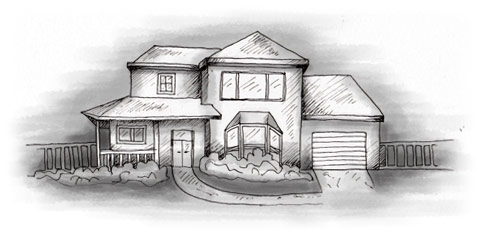Obviously, the extent of this will depend on whether it’s an old house in need of complete restoration, a property that has been partly or totally modernised, or a modern home. One of the problems with a property that has been restored is that you don’t know how well the job has been done, particularly if the owner did it himself, although he may have had to obtain local bye-law approval, in which case certain standards will have been met. If work has been carried out by local builders, you should ask to see the bills.
There are certain things you can test yourself, including the electrical system, plumbing, mains water, hot water boiler and central heating. Don’t take someone’s word that these are functional, but check them for yourself. If a property doesn’t have electricity or mains water, check the nearest connection point and the cost of extending the service to the property, as it can be very expensive in some rural areas. If a property has a well or septic tank, you should have it tested.
An old property may show visible signs of damage and decay, such as bulging or cracked walls, rising damp, missing roof slates (you can check with binoculars) and rotten woodwork. Common problems also include rusting water pipes and leaky plumbing, inadequate sewage disposal, poor wiring, humidity and rising damp (no damp-proof course), uneven flooring or no concrete base, subsidence, and cracked internal and external walls. Some of these problems are even evident in relatively new properties.
In areas that are liable to flooding, storms or subsidence, you should check an old property after heavy rain, when any leaks should come to light. If you find or suspect problems, you should have a property checked by a builder or have a full structural survey carried out by a surveyor.
You should never make an offer on an old property before at least having it checked by a builder, who will also be able to tell you whether the price is too high, given any work that needs to be done. It’s important to check who was the developer or builder of a relatively new property, as a builder with a good reputation is unlikely to have cut corners.
Note that a property over ten years old will no longer be covered by a builder’s warranty. If you require a mortgage to buy a property, the lending institution (e.g. bank or building society) will require at least a valuation report, which, as well as verifying the value of the property, will usually reveal any major defects. However, a valuation report won’t necessarily tell you whether there are (or are likely to be) minor problems such as unsafe wiring or a leaking roof. Therefore it’s prudent to obtain a full structural survey, which will reveal any major or minor defects in a property and indicate the likely cost of any repairs or renovations required. If serious problems are discovered that would be expensive to rectify, you may decide to look for another property or negotiate a reduction in the price with the vendor. Note that your mortgage lender may insist on a structural report if a property is over 100 years old.
You could ask the vendor to have a survey done at his expense, which, provided it gives the property a clean bill of health, will help him sell it even if you decide not to buy. However, it’s unlikely that he will agree to this as buying property in Ireland is very much a case of caveat emptor (buyer beware)! You can employ a foreign surveyor practising in Ireland. However, an Irish surveyor may have a more intimate knowledge of local properties and building methods.
If you employ a foreign surveyor, you must ensure that he’s experienced in the idiosyncrasies of Irish properties and that he has professional indemnity insurance covering Ireland (which means you can happily sue him if he does a bad job!).
Always discuss with a surveyor exactly what will be included and, most importantly, excluded from a survey (you may need to pay extra to include certain checks and tests). A full structural survey should include the condition of all buildings, particularly the foundations, roofs, walls and woodwork, the plumbing, and the electrical and heating systems.
A survey can be limited to a few items or even a single system, such as the wiring or plumbing in an old house. You should receive a written report on the structural condition of a property, including anything that could become a problem in the future. Some surveyors allow you to accompany them and provide a video film of their findings in addition to a written report.
Land
Before buying a home with a plot of land, you should walk the boundaries and look for fences, driveways, roads, and the eaves of buildings that may be encroaching upon the property. If you’re uncertain about the boundaries, you should have the land surveyed, which is recommended in any case when buying a property with a large plot of land.
When buying a rural property in Ireland, you may be able to negotiate the amount of land you want included in the purchase. If a property is part of a larger plot owned by the vendor or the boundaries need to be redrawn, you’ll have to hire a surveyor to measure the land and draw up a new cadastral plan. You should also ask your solicitor to check the local municipal plans to find out what the land can be used for and whether there are any rights of way across it.

